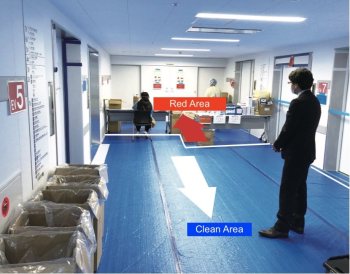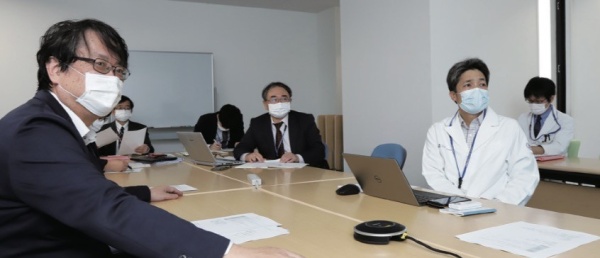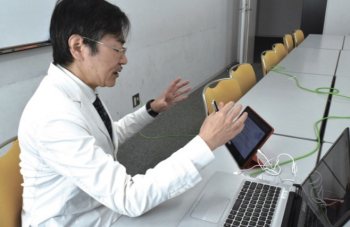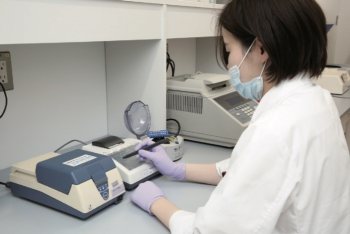At Fujita Academy, both the University and the Hospital have implemented initiatives designed to hasten the control of the novel coronavirus. In addition to infection-prevention measures, we are also engaged in the clinical study of remedy for the disease and the assessment of tests that can quickly detect the virus. These efforts have been the focus of attention around the world.
An example of a successful anti-infection measure, “Fujita Model” know-how provided to facilities observing the progress of patients with mild symptoms
 Zone separation has been completely implemented throughout the Okazaki Medical Center.
Zone separation has been completely implemented throughout the Okazaki Medical Center.
As efforts to use hotels and other lodgings for the care of patients with mild cases of novel coronavirus infection, physicians from the Department of Infectious Diseases at our University are cooperating with the Prefectural Government of Aichi Prefecture as it works toward establishing a public observation center for patients with mild disease. They serve as advisors who provide input regarding infection-prevention measures such as zone separation.
The initiatives implemented at the Okazaki Medical Center designed to prevent secondary infections after accepting asymptomatic carriers and those who had close contact with infected persons and to monitor their health status are collectively known as the “Fujita Model.” This model is being hailed as a leading example of how to effectively prevent the spread of infection. In order to put the experience and knowledge gained from these initiatives to good use, they are being provided to physicians and other medical personnel as an infection-prevention protocol for use in centers that observe patients with mild disease throughout Japan.
Clinical study of the anti-viral medication Favipiravir is on-going
At the Fujita Health University, we are engaged in an observational study and specified clinical trial of Favipiravir (Avigan) as part of a research and development project being conducted by the Japan Agency for Medical Research and Development (AMED). The key researchers involved in this project are Professor Yohei Doi of the Department of Infectious Diseases and Masahi Kondo, Director of the Center for Clinical Trial and Research Support.
The observational study is designed to follow up on post-administration improvements in symptoms. Approximately 200 medical facilities throughout Japan are participating in this study. Approximately 300 patients with cases ranging from severe to mild were administered Favipiravir. Two weeks later it was found that between 80% and 90% of the mild to moderate cases and approximately 60% of the severe cases had experienced improvement. However, Professor Doi pointed out that a further study is required as in this study it was impossible to make comparisons with patients who were not administered the drug and because the results were affected by the administering physicians’ subjectivity.
The specific clinical study is a comparative study in which the percentage of virus disappearance was compared at different drug administration time points. Specifically, the subjects were divided into two groups of patients – those who were asymptomatic and those with mild cases of disease onset – who undergo drug administration from day 1 to day 6 of hospitalization after infection was confirmed. The percentage of the decrease in pharyngeal virus amount after drug administration is then compared over a period of 10 days.
The final outcome report with a target of 86 subjects is scheduled for release in August.
 A web-based meeting related to the Favipiravir clinical study.
A web-based meeting related to the Favipiravir clinical study.
Remote learning via the web
 Professor Hiroshi Nagasaki of the Medical Department/Physiology I class delivering a class lecture via the web.
Professor Hiroshi Nagasaki of the Medical Department/Physiology I class delivering a class lecture via the web.
Remote learning via live internet feed has begun at our university, graduate school, and school of nursing. This allows classes to be conducted in real time in an interactive way. We have also begun an initiative to provide effective learning opportunities through the use of the unique characteristics of the live feed. Included among the initiatives we are examining are conducting portions of some clinical practice courses – e.g. course material and conferences – on the web.
In addition, physical participation in extra-curricular activities and events that require people to go outside or meet face-to-face with others are subject to self-imposed restrictions (cancellations or postponements), and we are working on infection-prevention measures for our students and staff.
Assessment of PCR testing equipment, antibody test kits, and rapid detection performance currently being investigated
 Rapid testing devices have been distributed to Fujita Health University Hospital for use in emergency situations.
Rapid testing devices have been distributed to Fujita Health University Hospital for use in emergency situations.
At our university, we are assessing and investigating PCR testing equipment designed to rapidly detect the novel coronavirus as well as the antibody detection performance of immunochromatography in cooperation with the Japan Agency for Medical Research and Development (AMED) and at the request of multiple diagnostic pharmaceutical companies. Specifically, the Department of Infectious Diseases, Clinical Laboratory Department, and School of Health Science formed a team to assess the performance of a device that can complete the test results for a single patient within 90 minutes of sample collection. This device has the same sensitivity as the PCR test recommended by the National Institute of Infectious Diseases and has been shown to be extremely effective for use in clinical diagnosis. In May, an announcement on a rapid testing device that can produce results in an even shorter period of time – 75 minutes – was scheduled. We are also actively involved in the assessment of the performance of an antibody testing kit that can simply determine whether an individual has been exposed to the novel coronavirus in the past.
Furthermore, preparations for a PCR testing system at Fujita Health University Hospital have already been completed, and testing on an emergency basis began on April 6 at the Clinical Laboratory Department with the Department of Infectious Diseases acting as the consultation hub.
In order to bring the infection under control as soon as possible, our university continues to investigate the effectiveness and usefulness of these and other medical devices.
Functioning as a community medical coordination network during this time of emergency
Our university has dispatched personnel to the Minami Seikyo Hospital (Midori Ward, Nagoya City), which has temporarily suspended operations due to the confirmation of infection among hospitalized patients, through the Community Medical Cooperation Promotion Corporation “Bisankai” and the Fujita Safety Network. Hiroyuki Nagae, Director of Seikyo Hospital, sent us a message regarding the effort to promote community cooperation. On February 29, COVID-19 was confirmed in a patient who had been transferred from a local elderly care facility to the general medical ward at the Minami Seikyo Hospital. After the hospital was closed, a number of issues were discovered, and it was determined that it would be difficult for the hospital to resolve these issues on its own.
It was at this point that Bisankai dispatched Ayuko Yasuda, Director of the Quality Management in Healthcare Department. Her mission was to launch a COVID-19 CRISIS Conference (CCC), create a list of patients and hospital staff who had had close contact with the infected individual, and identify a scientific basis for declaring return to work and patient discharge to be “safe.” She dealt with a number of issues simultaneously and eventually succeeded in reopening the hospital without a single secondary infection. I would like to express my sincere appreciation to Hospital Director Yuzawa who made direct appeals for assistance during this time of need, and also to Dr. Yasuda who led the CCC system at our facility. We continue to make efforts to assist Bisankai as it continues to develop its useful and practical medical coordination system, and we express our appreciation for their efforts in this latest crisis.
